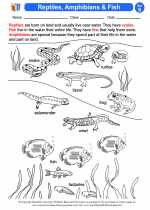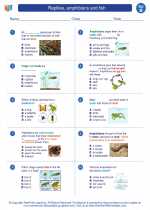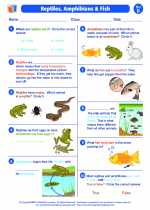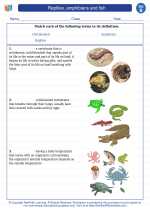Reptiles, Amphibians, and Fish Study Guide
Reptiles
Reptiles are cold-blooded vertebrates that have scales or scutes and breathe air. They are ectothermic, which means they rely on external sources of heat to regulate their body temperature.
- Characteristic features of reptiles include: scales, claws, and the ability to lay eggs with tough, leathery shells.
- Examples of reptiles include snakes, lizards, turtles, and crocodiles.
- Reptiles are found in a wide range of habitats, from deserts to forests and even in water.
Amphibians
Amphibians are cold-blooded vertebrates that typically have moist, permeable skin and undergo a metamorphosis from aquatic larvae to terrestrial adults.
- Characteristic features of amphibians include: smooth, moist skin and the ability to breathe through their skin and lungs.
- Examples of amphibians include frogs, toads, salamanders, and newts.
- Amphibians are found in a variety of habitats, including freshwater environments such as ponds, marshes, and rainforests.
Fish
Fish are cold-blooded vertebrates that live in water and respire through gills. They come in a wide variety of shapes, sizes, and colors.
- Characteristic features of fish include: scales, fins, and gills for breathing underwater.
- Fish are divided into two main groups: bony fish and cartilaginous fish.
- Examples of fish include trout, salmon, tuna, sharks, and rays.
- Fish inhabit various aquatic environments such as oceans, rivers, lakes, and streams.
Remember to review the key features and habitats of each group, and be prepared to identify specific examples of reptiles, amphibians, and fish.
.◂Science Worksheets and Study Guides Second Grade. Reptiles, amphibians and fish
Study Guide Reptiles, amphibians and fish
Reptiles, amphibians and fish  Activity Lesson
Activity Lesson Reptiles, Amphibians & Fish
Reptiles, Amphibians & Fish  Worksheet/Answer key
Worksheet/Answer key Reptiles, amphibians and fish
Reptiles, amphibians and fish  Worksheet/Answer key
Worksheet/Answer key Reptiles, amphibians and fish
Reptiles, amphibians and fish  Worksheet/Answer key
Worksheet/Answer key Reptiles, amphibians and fish
Reptiles, amphibians and fish  Worksheet/Answer key
Worksheet/Answer key Reptiles, Amphibians and Fish
Reptiles, Amphibians and Fish  Vocabulary/Answer key
Vocabulary/Answer key Reptiles, amphibians and fish
Reptiles, amphibians and fish 

 Activity Lesson
Activity Lesson
 Worksheet/Answer key
Worksheet/Answer key
 Worksheet/Answer key
Worksheet/Answer key
 Worksheet/Answer key
Worksheet/Answer key
 Worksheet/Answer key
Worksheet/Answer key
 Vocabulary/Answer key
Vocabulary/Answer key

The resources above cover the following skills:
LIFE SCIENCE (NGSS)
Ecosystems: Interactions, Energy, and Dynamics
Students who demonstrate understanding can:
Plan and conduct an investigation to determine if plants need sunlight and water to grow.